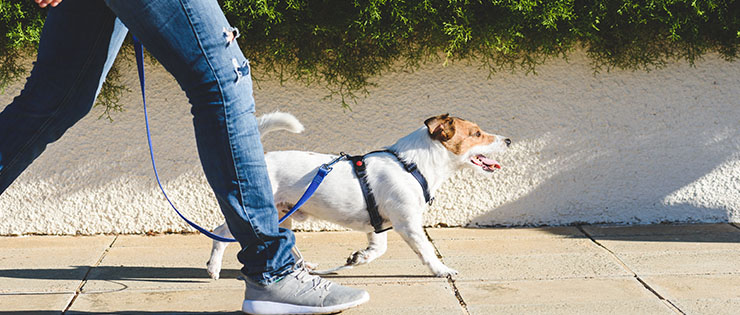
Walking your dog should be an enjoyable endeavour. It should be an opportunity to get exercise, bond with your dog, absorb the surroundings and allow your dog to check the daily pee-mails. A walk is essential. But, is your walk with your dog as enjoyable as it should be? If you answered no, then you are not alone. Many dogs pull on lead, and this can make the owner tired and frustrated, making them less likely to walk their dog. This can result in the walk being even more difficult the next time, because of pent up energy within the dog. It is a cycle that can seem difficult to shake. But rest assured, there is light at the end of the tunnel.
The best way to teach your dog to walk nicely on lead, is to motivate them to want to! This is done through showing them that engaging with you is JUST as good as pulling to sniff the next blade of grass. In fact, it is even better! So, the first step is to put your mobile phone in your pocket, and take the next 40 minutes your life to focus on the relationship with your four-legged best friend. Social media will wait. In fact, your next social media post may be far more interesting after you’ve had a great walk with your dog.
Here are my top tips to train your dog to enjoy walking nicely on lead
- Start your walks inside the house. It may seem strange, but walking your dog in an environment in which they are comfortable and focused, is the best place to start your training. This gives you the opportunity to reinforce the good behaviours effectively, before you introduce distractions.
- Ensure you have high value rewards. Find out what your dog loves and use these as a reward for your dog when they are at your side
- When there is tension on the lead (even the slightest amount) stop immediately and turn around, bringing your dog to a fast stop and U-turn. Allow a moment of quiet motionlessness and then move on.
- Put the walking on cue. As your dog walks beside you, introduce a word. This can be the word “heel”, which means to walk at your side. As your dog walks beside you, capture the moment with a high value reward and use a word such as ‘YES’. Introduce a marker word such as ‘YES’ wherever you can. This is something we use in training which lets our dog know that the behaviour they are doing is exactly what we are after, and a high value reward is likely on its way any moment.
- Allow your dog some freedom! Make heeling at your side part of a game, in which your dog starts to anticipate that cooperating with you results in some free play time. I like to use the word ‘FREE’ to communicate to my dogs that they are free to move about just as they wish and to explore what is in their surrounds
- (as long as it is safe). Remember, allowing your dog to freely explore their world is important. Simply heeling at your side is unlikely to be fulfilling to your dog, so allow them to smell, see and experience their walks with you, providing they can cooperate with you when you need them to.
Teaching your dog to walk on lead is a journey that takes time, so it is understandably advantageous to teach your dog when they are a puppy. Of course, this is not always possible, so ensure you take the time to practise your training under minimal distraction, before you expect too much. Also, remember to embrace the moments you have with your dog. The walk is a big deal to them, and after spending the majority of their day not engaging with the wide-open world (if you work full time), it is critical that you provide them with purpose, fun and unconditional acceptance each and every day!